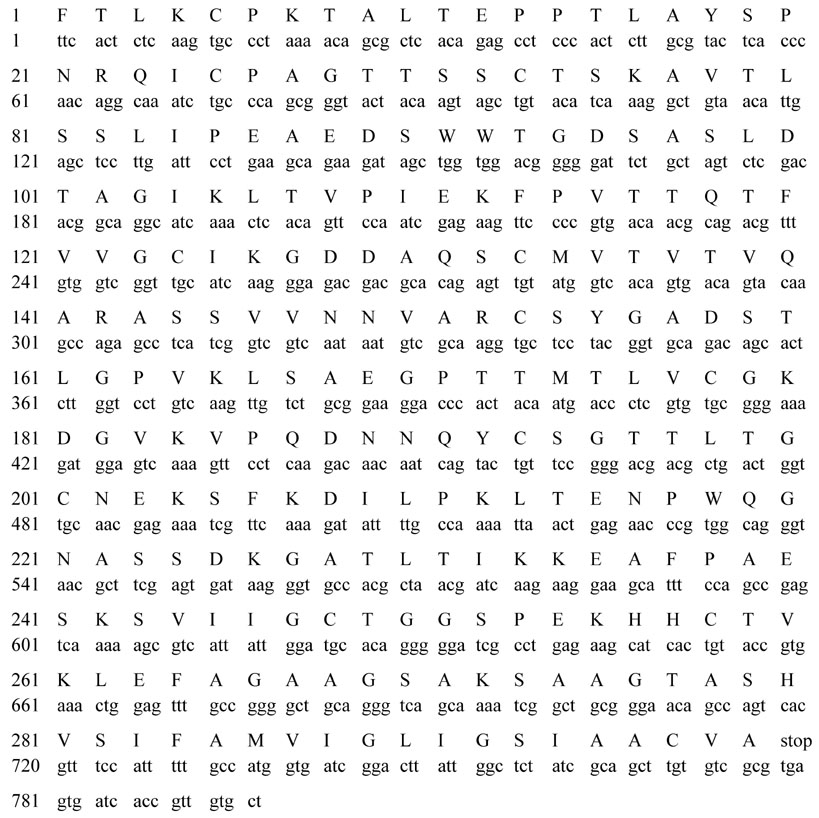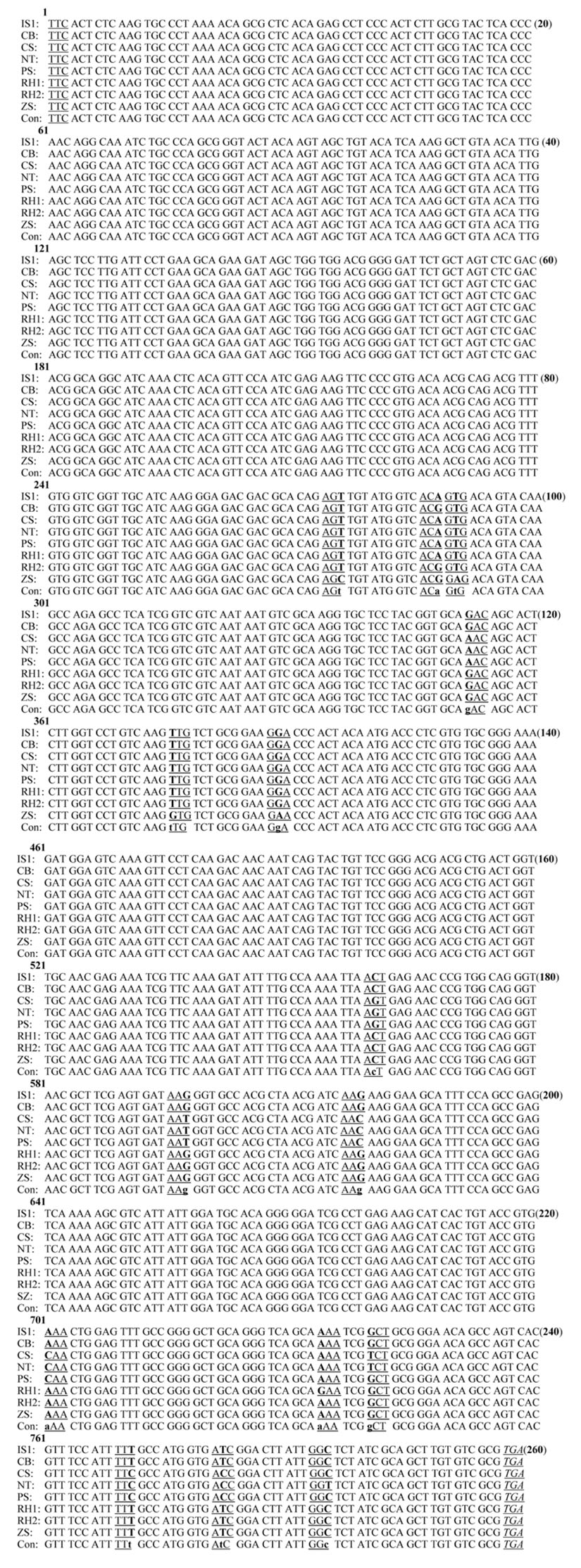J Vet Sci.
2006 Sep;7(3):263-270. 10.4142/jvs.2006.7.3.263.
Primary structure of mature SAG1 gene of an Indonesian Toxoplasma gondii and comparison with other strains
- Affiliations
-
- 1Department of Internal Medicine, Gadjah Mada University, Yogyakarta, 55281, Indonesia.
- 2Department of Reproduction, Faculty of Veterinary Medicine, Gadjah Mada University, Yogyakarta, 55281, Indonesia.
- 3Study Center of Biotechnology, Gadjah Mada University, Yogyakarta, 55281, Indonesia.
- 4Pathogens and Immunity, UMR5119, CNRS, Universite Montpellier II, 34095 Montpellier Cedex 5, France. widada@univ-montp2.fr
- KMID: 1089911
- DOI: http://doi.org/10.4142/jvs.2006.7.3.263
Abstract
- Toxoplasma gondii is a persistent protozoan parasite capable of infecting almost any warm-blooded vertebrates. SAG1 (p30) is the prototypic member of a superfamily of surface antigens called SRS (SAG1-related sequence). It constitutes the most abundant and predominant antigen. In this paper the primary structure of mature SAG1 gene of an Indonesian T. gondii isolate is described and sequence comparison is made with published sequence data of 7 other strains or isolates. Sequence comparison indicated that SAG1 is highly conserved through evolution and despite parasite spreading world-wide. Sequences may be divided into two major families, independent of the strain/isolate geographic origin. Variations were mainly localized at the C-terminal half or domain 2 and some clustered in restricted areas. Sequence comparison allowed us to define the Indonesian isolate as genuine virulent RH strain. A phylogenetic tree of Toxoplasma strains/isolates was constructed based on SAG1.
Keyword
MeSH Terms
-
Amino Acid Sequence
Animals
Antigens, Protozoan/chemistry/*genetics
Base Sequence
Cloning, Molecular
DNA, Protozoan/chemistry/genetics
Goat Diseases/parasitology
Goats
Indonesia
Molecular Sequence Data
Phylogeny
Polymerase Chain Reaction
Protozoan Proteins/chemistry/*genetics
Sequence Alignment
Sequence Analysis, DNA
Toxoplasma/*genetics/*immunology/isolation&purification
Toxoplasmosis/parasitology
Zoonoses/parasitology
Figure
Reference
-
1. Alix AJP. Predictive estimation of protein linear epitopes by using the program PEOPLE. Vaccine. 1999. 18:311–314.
Article2. Corpet F. Multiple sequence alignment with hierarchical clustering. Nucleic Acids Res. 1988. 16:10881–10890.
Article3. Cristina N, Dard ML, Boudin C, Tavernier G, Pestre-Alexandre M, Ambroise-Thomas P. A DNA fingerprinting method for individual characterization of Toxoplasma gondii strains: combination with isoenzymatic characters for determination of linkage groups. Parasitol Res. 1995. 81:32–37.
Article4. Dobrowolski JM, Sibley LD. Toxoplasma invasion of mammalian cells is powered by the actin cytoskeleton of the parasite. Cell. 1996. 84:933–939.
Article5. Dubremetz JF. Host cell invasion by Toxoplasma gondii. Trends Microbiol. 1998. 6:27–30.6. Godard I, Estaquier J, Zenner L, Bossus M, Auriault C, Darcy F, Gras-Masse H, Capron A. Antigenicity and immunogenicity of P30-derived peptides in experimental models of toxoplasmosis. Mol Immunol. 1994. 31:1353–1363.
Article7. Grimwood J, Smith JE. Toxoplasma gondii: the role of parasite surface and secreted proteins in host cell invasion. Int J Parasitol. 1996. 26:169–173.
Article8. He XL, Grigg ME, Boothroyd JC, Garcia KC. Structure of the immunodominant surface antigen from the Toxoplasma gondii SRS superfamily. Nat Struct Biol. 2002. 9:606–611.9. Howe DK, Sibley LD. Toxoplasma gondii comprises three clonal lineages: correlation of parasite genotype with human disease. J Infect Dis. 1995. 172:1561–1566.
Article10. Jung C, Lee CY, Grigg ME. The SRS superfamily of Toxoplasma surface proteins. Int J Parasitol. 2004. 34:285–296.11. Kasper LH, Bradley MS, Pfefferkorn ER. Identification of stage-specific sporozoite antigens of Toxoplasma gondii by monoclonal antibodies. J Immunol. 1984. 132:443–449.12. Kimbita EN, Xuan X, Huang X, Miyazawa T, Fukumoto S, Mishima M, Suzuki H, Sugimoto C, Nagasawa H, Fujisaki K, Suzuki N, Mikami T, Igarashi I. Serodiagnosis of Toxoplasma gondii infection in cats by enzyme-linked immunosorbent assay using recombinant SAG1. Vet Parasitol. 2001. 102:35–44.
Article13. Sibley LD, Boothroyd JC. Virulent strains of Toxoplasma gondii comprise a single clonal lineage. Nature. 1992. 359:82–85.
Article14. Hartati S, Wuryastuti H, Widada S, Sumartono , Kusumawati A. Kloning dan ekspresi gen penyandi SAGI Toxoplasma gondii isolat lokal pada vektor pGEX-2T. J Sain Vet. 2004. 22:19–22.15. Hartati S, Widada S, Sumartono , Kusumawati A. Cloning of the gene encoding SAGI of local isolate Toxoplasma gondii in E. coli DH5á. J Sain Vet. 2003. 21:51–56.16. Wong SY, Remington J. Toxoplasmosis in pregnancy. Clin Infect Dis. 1994. 18:853–861.
Article17. Zangerle R, Allerberger F, Pohl P, Fritsch P, Dierich MP. High risk of developing toxoplasmic encephalitis in AIDS patients seropositive to Toxoplasma gondii. Med Microbiol Immunol. 1991. 180:59–66.
- Full Text Links
- Actions
-
Cited
- CITED
-
- Close
- Share
- Similar articles
-
- Toxoplasma gondii virulence prediction using hierarchical cluster analysis based on coding sequences (CDS) of sag1, gra7 and rop18
- Fine structure of Toxoplasma gondii
- Evaluation of Recombinant SAG1, SAG2, and SAG3 Antigens for Serodiagnosis of Toxoplasmosis
- Molecular epidemiology of Toxoplasma gondii in cattle in Korea
- Real-Time RT-PCR on SAG1 and BAG1 Gene Expression during Stage Conversion in Immunosuppressed Mice Infected with Toxoplasma gondii Tehran Strain




